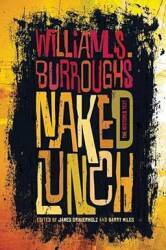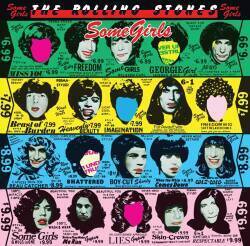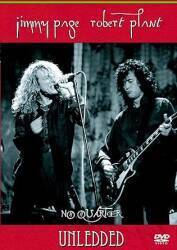
Café Hafa and the Strait of Gibraltar
Sipping Mint Tea Overlooking the Strait of Gibraltar
Tangier is at the western end of the
Strait of Gibraltar,
where it opens into the Atlantic Ocean.
Café Hafa is a famous café,
opened in 1921 and little changed today.
It overlooks the strait from the top of a steep slope,
almost a sheer cliff.
The composer and writer Paul Bowles frequented Café Hafa.
He led William S. Burroughs, the Rolling Stones,
and other writers and artists to frequent it.
Strong, sweet mint tea, hashish, and the fantastic views
made it popular.
The café is much as it always has been,
although with less hashish and celebrities these days.
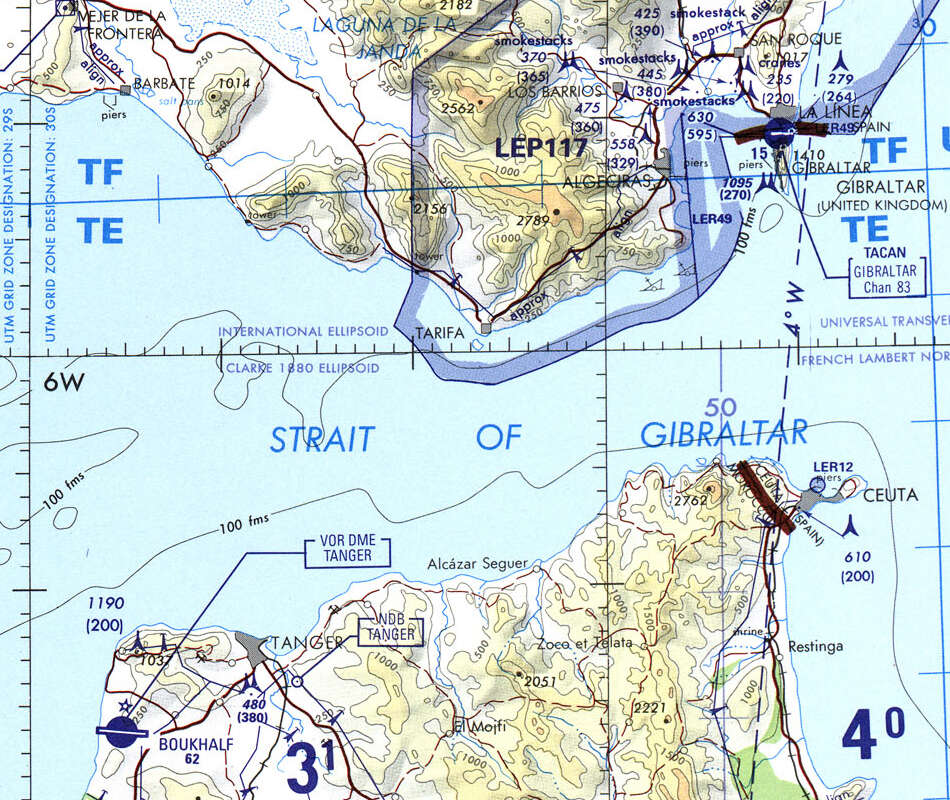
Portion of Tactical Pilotage Chart G-1D from the Perry-Castañeda Library Map Collection at the University of Texas at Austin.
Paul Bowles, the Proto-Beat
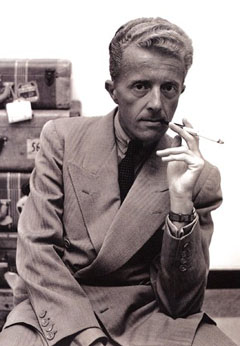
Paul Bowles was an American composer, author, and ethnomusicologist.
He wrote novels, short stories, and travel narratives, and made a series of field recordings of traditional Moroccan music for the US Library of Congress from 1959 to 1961.
He was a louche sort, studying music under Aaron Copland and then becoming his lover. They visited Tangier in July through October of 1931.
Bowles married the writer and playwright Jane Auer in 1938. While they retained a close personal connection until she died in 1973, both preferred physical intimacy with people of their own sex. They joined the Communist Party for a brief time, until Paul was kicked out of it.
Paul and Jane settled in Tangier in 1947, and he lived there until his death in 1999. He came to know William S. Burroughs while Burroughs lived in Tangier from 1953 until 1959 while writing Naked Lunch.
See the page on the Tangier American Legation for more on the Paul Bowles Wing maintained there. Among other things, you can see the luggage in the background of this photo, and hear some of the Moroccan music he recorded. That page has links to hear some of the music on line.
Paul Theroux wrote of Bowles in his introduction to Bowles' Travels.
Paul Bowles of the stereotype is the golden man, the enigmatic exile, elegantly dressed, a cigarette holder between his fingers, luxuriating in the Moroccan sunshine, living on remittances, occasionally offering his alarming and highly polished fictions to the wider world.
Café Hafa
France and Spain established Protectorates in 1912 through which they controlled the territory of today's Morocco. France controlled the bulk of today's Morocco. Spain controlled a narrow strip along the northern coast, including Tangier, and another narrow strip along the southern border with Spanish Sahara. Spain wanted the Spanish Sahara for the adjacent fishing rights. It contains some of the most inhospitable territory in the world, with little resources in its sand-covered land beyond a small amount of phosphates.
A man named Ba Mohamed opened the cliff-top Café Hafa in 1921.
Just two years later, in 1923, France, Spain, and the UK finalized the Tangier Protocol and made the city and some surrounding territory a neutral zone, the Tangier International Zone, under their joint administration. There was no military presence, no taxes, and no tariffs.
That began a period of about 35 years during which Tangier was a hotbed of international intrigue, espionage, and drug trafficking. The intrigue lasted through Morocco's independence in 1956 until about 1960. That was the end of the International Zone, but the drug traffic held on longer.
In 2022 the entrance and the interior still looked much as they did over a century before. The menu was above the door when I visited — just 10 Dirham (a little under US$ 1) for mint tea, 12 Dirham for coffee.

Cheap plastic chairs have replaced cheap metal and wooden ones. Otherwise, little has changed. Over the years Ba Mohamed turned down many enticing offers to purchase the café.
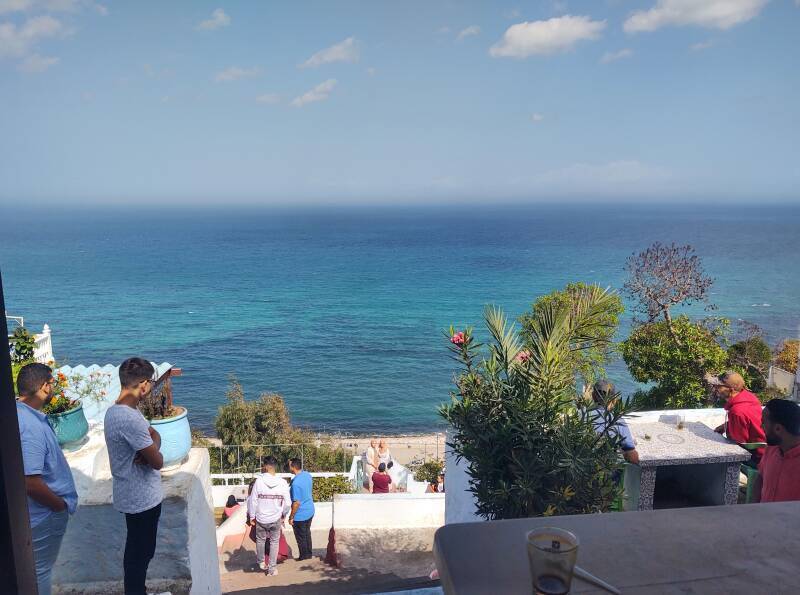
Meanwhile, the International Zone became a hotbed of intrigue and espionage. It was already a center of trafficking in marijuana and hashish, produced just to the east in the Rif mountains, and in opium derivatives due to Tangier having been granted the monopoly on the importation of opium to Morocco in 1880.
In his book "Tangier or the City of a Thousand and One Lights", Bowles wrote:
I go back to the Hafa café, however. It is on its terrace that I continue to dream. Time has changed everything except this place. Secret and silent, the Hafa café has remained as before, magical. Generation after generation, this is where chess players, poets, writers, and artists meet. And, installed on the old straw mats, they still abandon themselves to the sweet illusions of Kif.
Kif or Kief is a fine powder, the result of mechanical separation of the trichomes or resin glands from the flowering buds of cannabis. It can be heated and compressed into hashish, which can then be smoked or eaten. Hashish has been produced and consumed across North Africa to India for many centuries.
According to the timeline in Travels, a collection of his short stories, Bowles began using kif and majoun, a confection of marijuana seeds and kif in jam, in 1947.

Keef and kif — Keith Richards smoking kif in a sibsa, a specialized pipe.
Café Hafa is known and loved for its ramshackle construction. The different seating levels are joined by awkward staircases with too-tall steps of inconsistent heights.
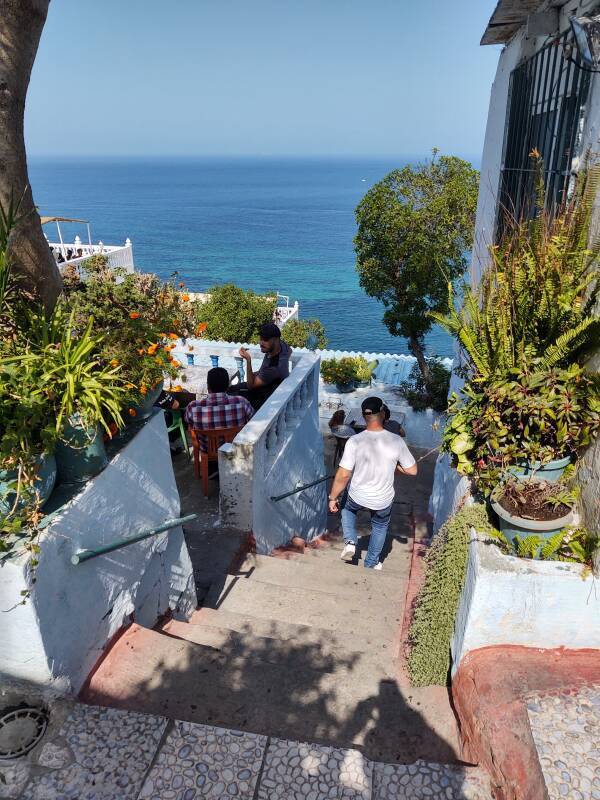
Some tables are rickety affairs of metal and wood.

Most of the tables are crude structures of blocks and concrete topped with simplified versions of the typically Moroccan zellij mosaic tilework with intricate geometric patterns.
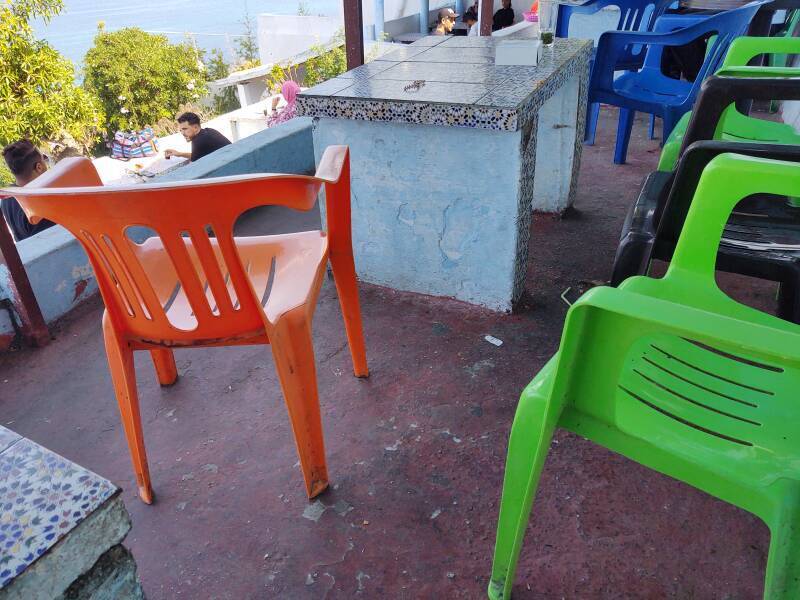
The chairs are cheap plastic ones, several of which will be broken on any given day.
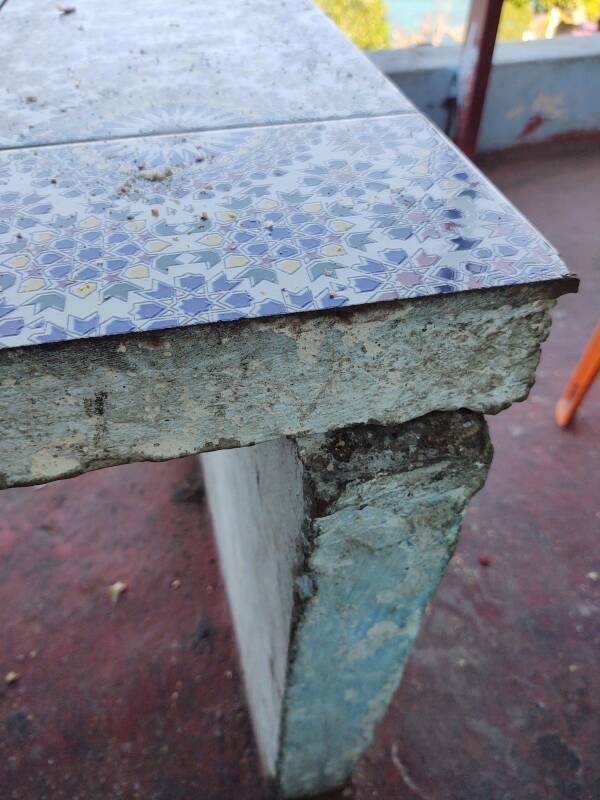
Other famous writing figures who have spent time here include Jean Genet, a French thief turned author who became an inspiration to the Beat Generation, and the painter, writer, and performance artist Brion Gysin.
The Rolling Stones came here many times, starting in the 1960s. That led to visits through the 1960s into the 1970s by other musicians, including Jimi Hendrix.
Morocco has amazing musical traditions. Paul Bowles was documenting and preserving this. The music museum in Meknès provided an immersive experience for me later in the trip. Jimmy Page and Robert Plant recorded their No Quarter album at the Jamaa el-Fnaa in Marrakech accompanied by a group of Moroccan musicians.
Strait of Gibraltar
The view from Café Hafais fantastic, looking out over the Strait of Gibraltar from about 60 to 80 meters above the waterline.
Below, the view to the right is toward the east and you can see the far side of the bay, across the port of Tangier.
The Strait of Gibraltar is just thirteen kilometers wide at its narrowest point, to the east of here. But Tangier is toward the east end of the strait where it widens and opens into the Atlantic, and it's a little over thirty kilometers to Spain from here. The far shore is hidden in the haze near the water surface on many days, like what you see in these pictures.
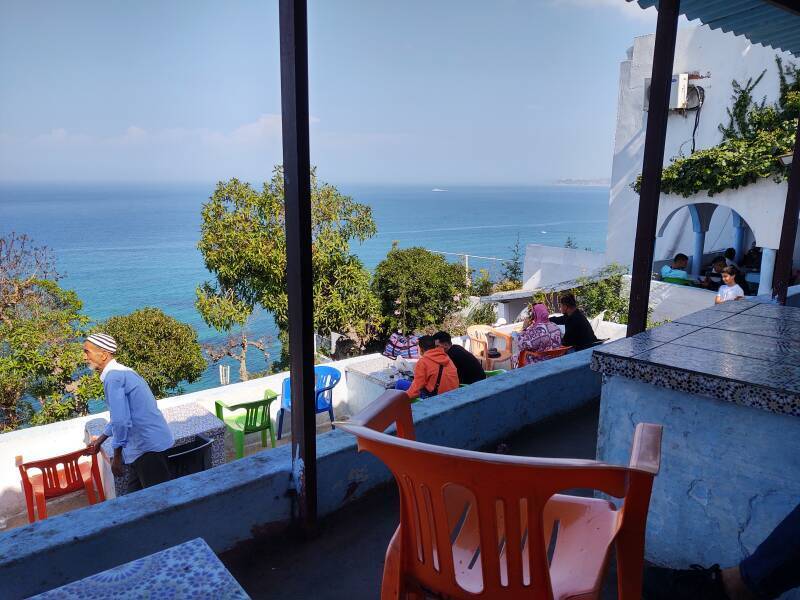
Radar
On most days you can see cargo ships passing through the Strait. Ships travel on the right, so you will see the east-bound traffic into the Mediterranean, which passes closer to the southern shore. The Marine Radar smartphone app lets you figure out what you're seeing. What's the ship, what type is it (bulk carrier, oil tanker, LNG tanker, general cargo), what was its last port, and where is it headed.
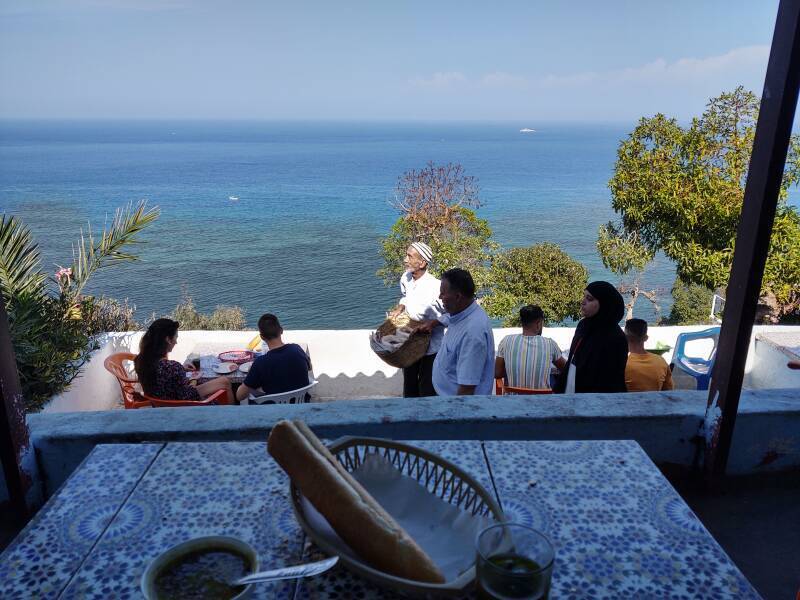
About 5.9 million years ago the connection between the Mediterranean and the Atlantic closed off. Water in the Mediterranean rapidly evaporated, greatly increasing its salinity and dropping its level.
Then, about 5.33 million years ago, in what is called the Zanclean flood, water began pouring through this strait and rapidly refilled the Mediterranean basin. It was a flow of an estimated 100 million cubic meters of water per second, about 1000 times that of the Amazon River, raising the water level within the Mediterranean basin up to 10 meters per day.
All that violently rushing water eroded the Strait, making for its current depth of 900 meters at the narrows.
People have lived here for a very long time. Homo sapiens were here by 40,000 years ago. Sites around the Rock of Gibraltar on the Spanish side may have been home to some of the last Neanderthal people in the world, as recently as 24,000 years ago.
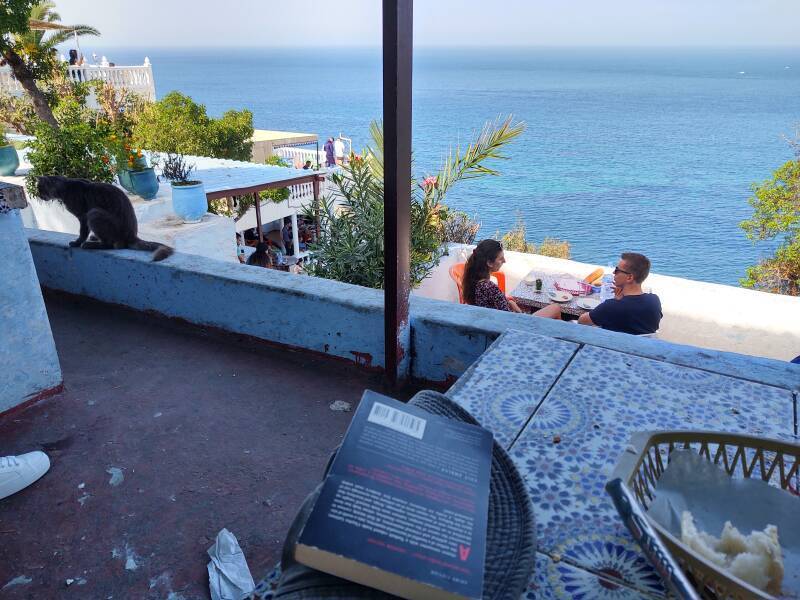
The Mediterranean Sea gets a lot of sun, and more water evaporates out of it than what flows in through all the rivers feeding into it. The result is that its water is significantly saltier, and thus denser, than water in the Atlantic.
Relatively fresher and lighter water flows in from the Atlantic near the surface, while saltier and denser water flows out beneath it. The density boundary is around 100 meters deep.
Nazi Germany took partial advantage of this during the Second World War, floating U-boats into the Mediterranean with their engines shut off and maintaining silence on board. Out of 81 U-boats attempting this, 9 were sunk after being detected anyway (probably by radar), 10 had to abandon the attempt due to damage, but 62 made it through the British-controlled Strait into the Mediterranean. None of them ever made it back out into the Atlantic, all were either sunk in battle or scuttled by their crews.
Food and Drink
The local specialty is bissara, split-pea soup made with garlic, cumin, and olive oil. A bowl costs just 10 Dirhams.
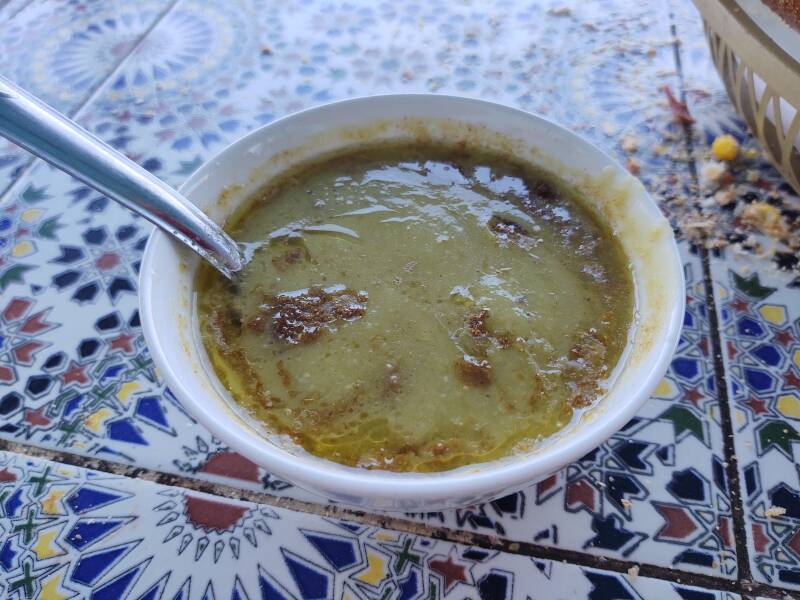
Accompanied, of course, by thé à la menthe, boiling hot tea made with a lot of sugar and spearmint leaves.
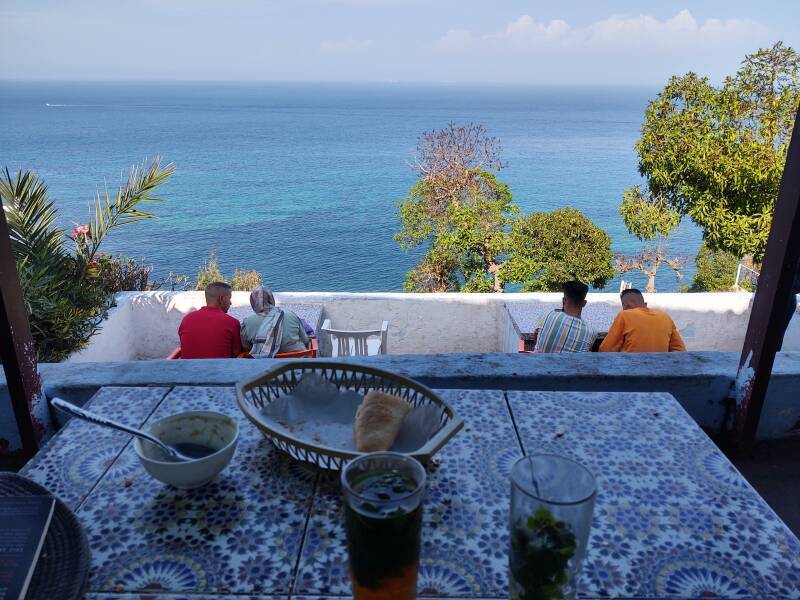
The Phoenician Tombs
On your way to or from Café Hafa you pass rock-cut Phoenician tombs overlooking the Strait of Gibraltar.
The Punic people, the western Phoenicians, set up a trading post at today's Tangier around 1450 BCE.
A later group established a large colony, which led to this necropolis. Carthage was the largest Punic settlement. The site of Tangier became one of the main ports of their empire by the 6th century BCE.
From the main street you can see that there's an open area looking like a small park with the open sea beyond it. Go back that side street, past the téléboutique.

Be aware that, at least in English, the Punics were Phoenicians and not Phone-icians, despite the apparent association of this shop. But if it helps you find the necropolis, that's great.

A nearby informational sign explains in French, Arabic, and the English shown here with slight fixes:
The famous ancient graves that made the Punic-Roman necropolis of Hafa on the cliff of the plateau of Mershan is located approximately 450 meters from the rampart of the Kasbah. Most of the graves face the sea, but a smaller number is located in the south alongside Rue Ibn al Abbar (once called Paseo Cenarro).
By their location, the graves indicate the location of the old gates of Tangier that delimit the area of the ancient city on the west side.
98 graves were exhumed by the early excavations undertaken in 1910 and by the last ones accomplished in 1960. More than 50 of them were shaped in the form of a box engraved in the rocks. Each grave is approximately 70 centimeters depth, 1.80 meters long, and 60 centimeters wide. However, today only two dozen of them can be found.
Punic and neo-Punic artifacts with Roman material were found in this site. In the first century AD, when the Romans occupied the region of Tangier, the necropolis was cleaned and emptied of it content to make room for new burials. The final phase of this occupation goes back to the Bas-Empire, around the end of the 4th century CE (395-425 CE).
Despite the fact that few archaeological artifacts were found in the necropolis, those that were discovered are funerary objects of great patrimonial importance. The unique sarcophagus of lead that is exhibited contains the remains of a child, an urn, a small broken glass vase, and fragments of a small statue.

Today it's a popular place where the local people gather. Fantastic views over the port and the Strait, and the kids can run around and jump in and out of the holes. Young couples come here, as few places are more romantic than a cliff-side necropolis.

Now for more about the Beat Generation in Tangier.
